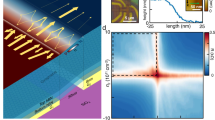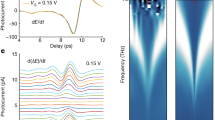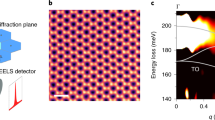Abstract
Matter-wave interferometry has become an essential tool in studies on the foundations of quantum physics1 and for precision measurements2,3,4,5,6. Mechanical gratings have played an important role as coherent beamsplitters for atoms7, molecules and clusters8,9, because the basic diffraction mechanism is the same for all particles. However, polarizable objects may experience van der Waals shifts when they pass the grating walls10,11, and the undesired dephasing may prevent interferometry with massive objects12. Here, we explore how to minimize this perturbation by reducing the thickness of the diffraction mask to its ultimate physical limit, that is, the thickness of a single atom. We have fabricated diffraction masks in single-layer and bilayer graphene as well as in a 1 nm thin carbonaceous biphenyl membrane. We identify conditions to transform an array of single-layer graphene nanoribbons into a grating of carbon nanoscrolls. We show that all these ultrathin nanomasks can be used for high-contrast quantum diffraction of massive molecules. They can be seen as a nanomechanical answer to the question debated by Bohr and Einstein13 of whether a softly suspended double slit would destroy quantum interference. In agreement with Bohr's reasoning we show that quantum coherence prevails, even in the limit of atomically thin gratings.
This is a preview of subscription content, access via your institution
Access options
Subscribe to this journal
Receive 12 print issues and online access
$259.00 per year
only $21.58 per issue
Buy this article
- Purchase on Springer Link
- Instant access to full article PDF
Prices may be subject to local taxes which are calculated during checkout



Similar content being viewed by others
References
Arndt, M. & Hornberger, K. Testing the limits of quantum mechanical superpositions. Nature Phys. 10, 271–277 (2014).
Cronin, A. D., Schmiedmayer, J. & Pritchard, D. E. Optics and interferometry with atoms and molecules. Rev. Mod. Phys. 81, 1051–1129 (2009).
Rosi, G., Sorrentino, F., Cacciapuoti, L., Prevedelli, M. & Tino, G. M. Precision measurement of the Newtonian gravitational constant using cold atoms. Nature 510, 518–521 (2014).
Bouchendira, R., Cladé, P., Guellati-Khélifa, S., Nez, F. & Biraben, F. New determination of the fine structure constant and test of the quantum electrodynamics. Phys. Rev. Lett. 106, 080801 (2011).
Dickerson, S. M., Hogan, J. M., Sugarbaker, A., Johnson, D. M. S. & Kasevich, M. A. Multiaxis inertial sensing with long-time point source atom interferometry. Phys. Rev. Lett. 111, 083001 (2013).
Geiger, R. et al. Detecting inertial effects with airborne matter–wave interferometry. Nature Commun. 2, 474 (2011).
Keith, D. W., Schattenburg, M. L., Smith, H. I. & Pritchard, D. E. Diffraction of atoms by a transmission grating. Phys. Rev. Lett. 61, 1580–1583 (1988).
Schöllkopf, W. & Toennies, J. P. Nondestructive mass selection of small van der Waals clusters. Science 266, 1345–1348 (1994).
Arndt, M. et al. Wave–particle duality of C60 molecules. Nature 401, 680–682 (1999).
Grisenti, R. E., Schöllkopf, W., Toennies, J. P., Hegerfeldt, G. C. & Köhler, T. Determination of atom–surface van der Waals potentials from transmission-grating diffraction intensities. Phys. Rev. Lett. 83, 1755–1758 (1999).
Lonij, V. P. A., Klauss, C. E., Holmgren, W. F. & Cronin, A. D. Atom diffraction reveals the impact of atomic core electrons on atom–surface potentials. Phys. Rev. Lett. 105, 233202 (2010).
Gerlich, S. et al. A Kapitza–Dirac–Talbot–Lau interferometer for highly polarizable molecules. Nature Phys. 3, 711–715 (2007).
Bohr, N. in Albert Einstein Philosopher–Scientist (ed. Schilpp, P. A.) 200–241 (Tudor, 1949).
Juffmann, T., Ulbricht, H. & Arndt, M. Experimental methods of molecular matter–wave optics. Rep. Prog. Phys. 76, 086402 (2013).
Bordé, C. J. Atomic interferometry with internal state labelling. Phys. Lett. A 140, 10–12 (1989).
Kasevich, M. & Chu, S. Atomic interferometry using stimulated Raman transitions. Phys. Rev. Lett. 67, 181–184 (1991).
Gould, P. L., Ruff, G. A. & Pritchard, D. E. Diffraction of atoms by light: the near-resonant Kapitza–Dirac effect. Phys. Rev. Lett. 56, 827–830 (1986).
Moskowitz, P. E., Gould, P. L., Atlas, S. R. & Pritchard, D. E. Diffraction of an atomic beam by standing-wave radiation. Phys. Rev. Lett. 51, 370–373 (1983).
Geim, A. & Novoselov, K. The rise of graphene. Nature Mater. 6, 183–191 (2007).
Lucot, D. et al. Deposition and FIB direct patterning of nanowires and nanorings into suspended sheets of graphene. Microelectron. Eng. 86, 882–884 (2009).
Liu, Z., Suenaga, K., Harris, P. & Iijima, S. Open and closed edges of graphene layers. Phys. Rev. Lett. 102, 015501 (2009).
Angelova, P. et al. A universal scheme to convert aromatic molecular monolayers into functional carbon nanomembranes. ACS Nano 7, 6489–6497 (2013).
Juffmann, T. et al. Real-time single-molecule imaging of quantum interference. Nature Nanotech. 7, 297–300 (2012).
Zimmermann, B. et al. Localization and loss of coherence in molecular double-slit experiments. Nature Phys. 4, 649–655 (2008).
Akoury, D. et al. The simplest double slit: interference and entanglement in double photoionization of H2 . Science 318, 949–952 (2007).
Liu, X.-J. et al. Einstein–Bohr recoiling double-slit gedanken experiment performed at the molecular level. Nature Photon. 9, 120–125 (2015).
Hamilton, P. et al. Antimatter interferometry for gravity measurements. Phys. Rev. Lett. 112, 121102 (2014).
Scheel, S. & Buhmann, S. Path decoherence of charged and neutral particles near surfaces. Phys. Rev. A 85, 030101(R) (2012).
Anglin, J. R., Paz, J. P. & Zurek, W. H. Deconstructing decoherence. Phys. Rev. A 55, 4041–4053 (1997).
Nairz, O., Arndt, M. & Zeilinger, A. Experimental verification of the Heisenberg uncertainty principle for fullerene molecules. Phys. Rev. A 65, 032109 (2002).
Garcia-Sanchez, D. et al. Imaging mechanical vibrations in suspended graphene sheets. Nano Lett. 8, 1399–1403 (2008).
Sapmaz, S., Blanter, Y. M., Gurevich, L. & van der Zant, H. S. J. Carbon nanotubes as nanoelectromechanical systems. Phys. Rev. B 67, 235414 (2003).
Lemme, M. C. et al. Etching of graphene devices with a helium ion beam. ACS Nano 3, 2674–2676 (2009).
Song, B. et al. Atomic-scale electron-beam sculpting of near-defect-free graphene nanostructures. Nano Lett. 11, 2247–2250 (2011).
Wei, D. & Liu, Y. Controllable synthesis of graphene and its applications. Adv. Mater. 22, 3225–3241 (2010).
Kotakoski, J. et al. Toward two-dimensional all-carbon heterostructures via ion beam patterning of single-layer graphene. Nano Lett. http://dx.doi.org/10.1021/acs.nanolett.5b02063 (2015).
Ramprasad, R. & Shi, N. Polarizability of phthalocyanine based molecular systems: a first-principles electronic structure study. Appl. Phys. Lett. 88, 222903 (2006).
Acknowledgements
The authors acknowledge support by the European Commission (304886), the European Research Council (320694) and the Austrian Science Funds (DK CoQuS W1210-3). C.B. acknowledges financial support from the Alexander von Humboldt Foundation through a Feodor Lynen fellowship. J.K. acknowledges the Austrian Science Fund FWF for funding through project M 1481-N20. J.M. and C.M. acknowledge support from the Austrian Science Funds FWF project P 25721-N20. A.W. and A.T. acknowledge support from the DFG (SPP ‘Graphene’ TU149/2-2, Heisenberg Program TU149/3-1). T.J. acknowledges support by the Gordon and Betty Moore Foundation. The authors thank the group of Prof. Schattschneider, USTEM TU Vienna for assistance in recording the image in Fig. 1h. The authors thank S. Scheel and J. Fiedler (University of Rostock) as well as K. Hornberger and B. Stickler (University of Duisburg) for discussions.
Author information
Authors and Affiliations
Contributions
M.A., O.C., T.J. and C.B. came up with the idea for the research. Nanofabrication was carried out by M.S., O.C. and Y.L. Grating characterization was performed by O.C., M.S., J.M., J.K., C.M., C.B. and Y.L. The biphenyl membrane was produced by A.W. and A.T. Diffraction experiments were carried out by M.S., C.K., C.B. and T.J. Simulations were performed by T.J., M.S., C.K., C.B. and M.A. The manuscript was written by M.A., C.B. and M.S., in collaboration with all co-authors.
Corresponding author
Ethics declarations
Competing interests
The authors declare no competing financial interests.
Supplementary information
Supplementary information
Supplementary information (PDF 766 kb)
Rights and permissions
About this article
Cite this article
Brand, C., Sclafani, M., Knobloch, C. et al. An atomically thin matter-wave beamsplitter. Nature Nanotech 10, 845–848 (2015). https://doi.org/10.1038/nnano.2015.179
Received:
Accepted:
Published:
Issue Date:
DOI: https://doi.org/10.1038/nnano.2015.179
This article is cited by
-
Cascaded collimator for atomic beams traveling in planar silicon devices
Nature Communications (2019)
-
Nanomechanical answer to Einstein
Nature Nanotechnology (2015)



